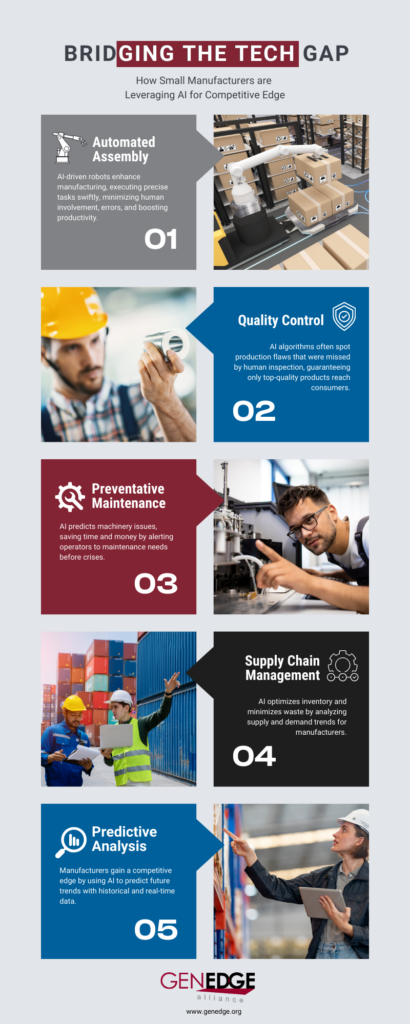ChatGPT has entered the chat.
Let’s talk about Artificial Intelligence (AI) and its impact on modern manufacturing. AI is no longer exclusive to sci-fi novels or giant tech companies; it’s a game-changer for how businesses are run. But what does this mean for small manufacturers? And what resources and IT support for manufacturers are available for them to ride this wave of technological innovation? We will try to answer these questions within this blog.
Unlock AI automation with innovative Advanced Manufacturing strategies!
We’ll cover what AI manufacturing is, how to use it, examples, and manufacturing strategies that benefit from AI. Human to human here’s what you need to know to Get access to AI automation with innovative Advanced Manufacturing strategies!

What is AI Manufacturing?
Artificial Intelligence (AI) in manufacturing, often known as AI Manufacturing, is the integration of AI technologies into traditional manufacturing procedures. Stemming from Industry 4.0’s advancements, this cutting-edge application enhances efficiency, productivity, and quality control. AI-powered machines can learn from their operations, adjust to new inputs, and perform human-like tasks with precision and speed. They can autonomously run complex processes, like assembly lines, and even detect faults in products or procedures early in the process. According to The World Economic Forum, AI automation is the new “Assembly Line 2.0.”
Also, AI gives predictive analysis for preventive maintenance, reducing downtime and repair costs. But don’t sweat this—we don’t mean an army of robots is coming to take over any time soon. Using AI as a tool offers tons of opportunities for streamlining operations and driving growth. The keyword is ‘tool,’ not ‘solution.’
Pro tip: GENEDGE is equipped to assist in the integration of advanced manufacturing technologies to enhance your competitiveness. We can help by providing in-person training and shop floor implementation consulting services.
How Manufacturers Use AI
- Automated Assembly
Robots are deeply involved in many manufacturing processes. AI-powered bots receive instructions and use them to complete tasks on assembly lines with preeminent precision and speed. They minimize the need for human intervention, reducing the risk of errors and increasing overall productivity. Watch these robots put a car together in mere minutes.
- Quality Control
AI algorithms are commonly used to identify faulty products in the production line. These systems can detect defects that might be missed by human inspection, ensuring that only high-quality goods reach consumers.
- Preventative Maintenance
AI helps manufacturers predict when machines might fail or require maintenance. By analyzing data on machine performance, AI can alert operators to issues before they become serious problems, saving time and money on repairs.
- Supply Chain Management
AI can analyze trends in supply and demand, helping manufacturers optimize their inventory and reduce waste.
- Predictive Analysis
With the help of AI, manufacturers can leverage historical and real-time data to predict future trends and make strategic decisions that give them a competitive edge.
AI in the Real World
In 2023, Artificial Intelligence (AI) has become increasingly important to the average manufacturer’s everyday operations. Today, AI technology in factories stretches beyond the robot-filled workplaces of the past to include smart, connected manufacturing plants where humans and machines work together.
- Cobots or Collaborative Robots
Used by automotive manufacturers like BMW and Ford along with consumer goods manufacturers like Procter & Gamble, these robots perform tasks like gluing, welding, greasing camshafts, injecting oil into engines, and conducting quality control inspections, all in collaboration with human workers.
- AI in Additive Manufacturing
AI improves 3D printing processes by optimizing material dispensation and application, enhancing product design, and identifying and rectifying print errors in real-time.
- Generative Design
This AI-driven design process accelerates product development by providing optimized design blueprints based on user-defined parameters like material usage, product size and weight, manufacturing methods, and cost.
- Predictive Maintenance
Using data from factory floor sensors and machinery, AI allows manufacturers to predict potential operational failures and breakdowns, enabling better resource allocation and less downtime.
- The Lights-Out Factory
An example of a theoretical AI application realized by companies like Japanese robotics manufacturer FANUC, a “lights-out factory” operates entirely autonomously, potentially improving output and efficiency significantly.

How You Can Enable AI
- Identify Opportunities
The first step is identifying where AI can make the biggest impact on your operations. Look for areas that are data-rich, repetitive, or prone to errors. This could be anything from quality control, supply chain management, predictive maintenance to customer service.
- Invest in the Right Tools
Once you’ve identified the opportunities, the next step is to invest in the right AI technologies. There are numerous resources and tools for small manufacturers, many designed specifically for the manufacturing industry. GENEDGE is equipped to assist in the integration of advanced manufacturing technologies to enhance your competitiveness. We can help by providing in-person training and shop floor implementation consulting services.
- Partner with IT Support
Implementing AI can be a complex process. Having the right IT support can make the transition smoother and more efficient. They can provide training, troubleshoot issues, and ensure the technology is integrated seamlessly into your operations.
- Prepare Data
AI systems require high-quality, reliable data to function effectively. Prepare your data by cleaning, classifying, and ensuring it’s stored in a format your AI system can use.
- Train Your Staff
Your employees will need to understand how to work with the new AI systems. Provide training and support, like GENEDGE’s Lean Six Sigma approach, to help them adapt to the changes.
- Monitor and Adjust
Finally, once the AI system is in place, monitor its performance and make adjustments as necessary. This might involve tweaking the system, providing additional training to staff, or investing in other resources.
Harnessing the Power of AI
Remember, implementing AI isn’t just about buying a new piece of technology. It’s about transforming the way you do business. By following these steps, you can leverage AI to gain a competitive edge, improve efficiency, and grow your business. GENEDGE gives expert AI help to small manufacturers in Virginia and beyond.
Comments? Questions? Let us know in the space below or email us: info@genedge.org



